This is the text version of a talk I gave on February 14, 2014, at Webstock in Wellington, New Zealand.
There's some material here that I skipped over during the actual talk, for lack of time. You can read the thing straight through or just skip to the angry rant.
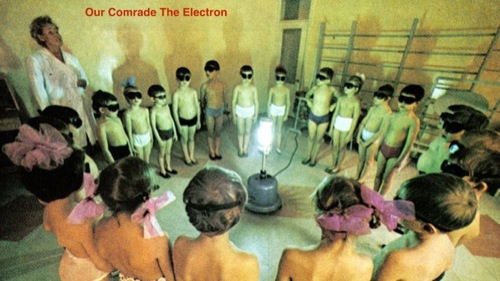 |
OUR COMRADE THE ELECTRON |
 |
In 1952, an American attaché in Moscow was innocently fiddling with his shortwave radio when he heard the voice of the American ambassador dictating letters in the Embassy, just a few buildings away. He immediately reported the incident, but though the Americans tore the walls out of the Ambassador's office, they weren't able to find a listening device. |
 |
When the broadcasts kept coming, the Americans flew in two technical experts with special radio finding equipment, who meticulously examined each object in the Ambassador's office. They finally tracked the signal to this innocuous giant wooden sculpture of the Great Seal of the United States, hanging behind the Ambassador's desk. It had been given as a gift by the Komsomol, the Soviet version of the Boy Scouts. Cracking it open, they found a hollow cavity and a metal object so unusual and mysterious in its design that it has gone down in history as ‘The Thing’. |
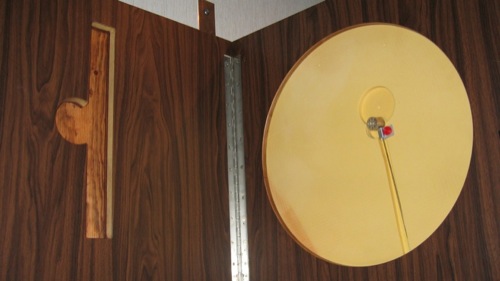 |
‘The Thing’ had no battery, no wires, no source of power at all. It was was just a little can of metal covered on one side with foil, with a long metal whisker sticking out the side. It seemed too simple to be anything. That night the American technician slept with ‘The Thing’ under his pillow. The next day they smuggled it out of the country for analysis. The Americans couldn't figure out how ‘The Thing’ worked, and had to ask the British for help. After a few weeks of fiddling, the Brits finally cracked The Thing's secret. |
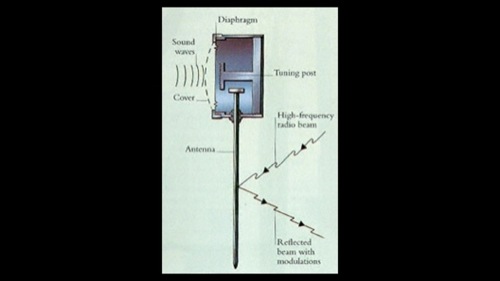 |
That little round can was a resonant cavity. If you shone a beam of radio waves at it at a particular frequency, it would sing back to you, like a tuning fork. The metal antenna was just the right length to broadcast back one of the higher harmonics of the signal. The resonator sat right behind a specially thinned piece of wood under the eagle's beak. When someone in the room spoke, vibrations in the air would shake the foil, slightly deforming the cavity, which in turn made the resonant signal weaker or stronger. As the attaché discovered, you could listen to this modulated signal on a radio just like a regular broadcast. ‘The Thing’ was a wireless, remotely powered microphone. It had been hanging on the ambassador's wall for seven years. |
 |
Today we have a name for what ‘The Thing’ is: It's an RFID tag, ingeniously modified to detect sound vibrations. Our world is full of these little pieces of metal and electronics that will sing back to you if you shine the right kind of radio waves on them. But for 1952, this was heady stuff. Those poor American spooks were up against a piece of science fiction. |
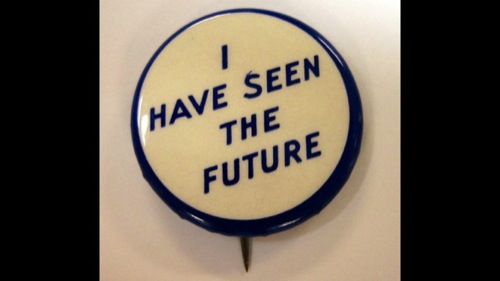 |
Today I want to talk about these moments when the future falls in our laps, with no warning or consideration about whether we're ready to confront it. Working in technology, we all have moments when it feels like the veil has been lifted, and we catch a glimpse of what's coming next. These moments are personal, but I'm sure you can all think of some in your own experience. An example from my life is the first time I tried wifi. It didn't seem like a big deal at the outset—why couldn't I just use a ten meter Ethernet cable, and enjoy the faster connection speed? |
 |
But that first time I checked my email from my sofa, with no wires going in the computer, I understood. From now on, the Internet wasn't going to be a thing I went somewhere to use. It would be all around us, like the ether, filling every space (except for this room). I knew it wouldn't happen immediately, but it was going to happen. And I loved that feeling of being privy to what would happen next. These glimpses can be addictive. For some of us, the sensation of having one foot in the future is what first attracted us to technology, or scifi. You people in New Zealand are especially lucky, being closer to tomorrow than almost anyone else. |
 |
But these glimpses are also deceptive. If you're not careful, you end up like this poor sap, AOL's digital prophet. Whenever we try to predict what it's actually going to be like to live in that future, what the future is going to taste like, we invariably fail, and in the most ridiculous ways. It's like a weird law of nature. We can see the technologies coming, but that knowledge somehow makes the future less predictable. |
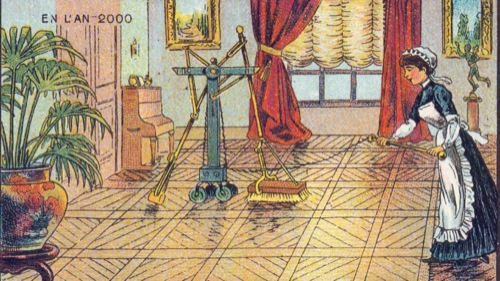 |
Perhaps we predict the Roomba a hundred years in advance, but set it in a world where women are still wearing crinoline and whalebone corsets. Or else we correctly predict that the Encyclopedia Britannica will one day fit on the head of a pin, never imagining that the Britannica itself will have become a relic, replaced by the free, collaborative, sprawling something called Wikipedia. Such predictions aren't wrong, they're "not even wrong", they miss the basic point. The future makes fools of us all. |
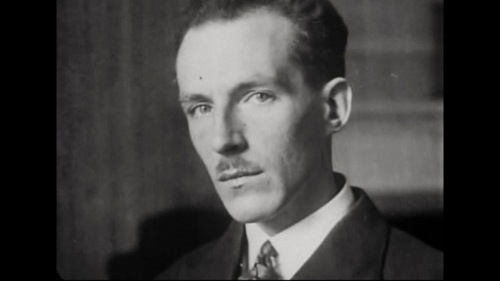 |
So today I want to talk about the past, about the man who designed that clever listening device, Lev Sergeyevich Termen. Termen was a visionary whose inventions were decades ahead of their time, but in his personal life he struggled against the unexpected. The poor guy always seemed to be stepping on the rake of Fate. Termen was born in Petersburg in 1896, to an aristocratic family. He was a musical child and became an accomplished cellist, but his greatest love was always physics and engineering. |
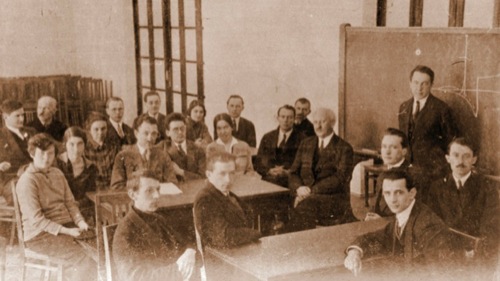 |
In 1917, Termen threw in his lot with the Bolshevik revolution, and was assigned to work at a new Soviet research laboratory. One of his first tasks was to build a capacitative sensor to measure the electrical properties of gases. It consisted of two metal plates; by introducing a gas sample between the plates you could take a reading. Instead of giving this instrument a regular dial for taking readings, Termen had the inspired idea of plugging in his headphones. The pitch of the signal in the headphones corresponded to the value of the reading. Termen noticed that when he moved his hands near the metal plates, it would affect the pitch. He taught himself to play a few melodies, and his colleagues got excited. "Termen is playing the voltmeter!" And that's the last the world heard of the gas analyzer. Termen got to work and soon had constructed the world's first electronic musical instrument. His colleagues called it the 'Termenvox', in his honor. We, of course, call it the theremin. |
 |
Here is a video of a cat playing the theremin. You see the instrument has a vertical antenna that controls pitch. As the cat moves its paws closer to the antenna, or bites it, the sound gets higher. There's also a horizontal coil, which the cat has elected not to use, that controls volume. You don't play the theremin by touching it—it's enough to just move your hands (or paws) nearby. |
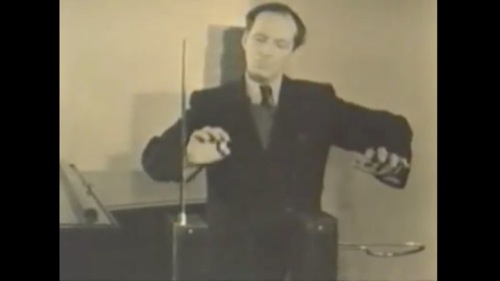 |
Here's a human being playing the theremin, a little more skillfuly. Please forgive the video quality, but this is Termen himself , demonstrating his invention. You'll notice how sensitive the theremin is to even small changes in hand position. Well, this was a huge hit with the boys down at the lab. And pretty soon Termen found himself invited to the Kremlin to give a demo to Lenin, a huge tech geek. He'd hit the big time! There are two themes that recur in Termen's work. The first is this idea of touching the intangible, palpating the impalpable, effing the ineffable. Termen loved to connect the invisible world of the electron to our physical senses, in astonishing ways. You see this in the theremin and you also see it in 'The Thing'; both devices couple sound to a high-frequency electromagnetic field. And that's the other theme, that everything Termen worked on seemed to have a dark side. Part of this was not his fault, just due to the amoral nature of physics. You can't have a world with a theremin without also being able to build 'The Thing'. The electrons don't care. |
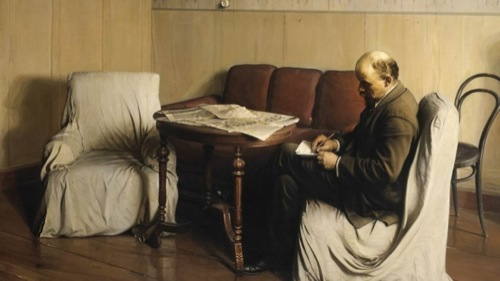 |
So Termen brought two devices to the Kremlin, a theremin and what you might call the theremin's big brother, a larger device called the Invisible Watchman. The Invisible Watchman was a modified theremin with a very tall antenna. It had a radius of action of several meters, and if you crossed the invisible line it would trigger a silent alarm, summoning goons to come get you. (Termen would later convince the Americans to test this device on the walls of Sing Sing prison.) Of course the Invisible Watchman was a big hit. Lenin instantly directed that it be used to guard the big stash of gold the Bolsheviks had stolen from the Orthodox Church. But the musical demo went even better. Lenin was delighted with the theremin and insisted on playing it himself. Like an old tennis pro, Termen stood behind the dictator and moved his arms until he was sure Lenin had the hang of it. Then he let go, and Lenin finished the tune by himself. He was so proud. It's a curiosity of history that all these revolutionary dictators, from Lenin to Steve Jobs, invariably have bourgeois, stodgy taste in music. Lenin played some schmaltzy folk song by Glinka. |
 |
Termen had good timing. Lenin was just about to launch a huge campaign under the curiously specific slogan: COMMUNISM = SOVIET POWER + ELECTRIFICATION OF THE WHOLE COUNTRY Why make such a big deal of electrification? Well, Lenin had just led a Great Proletarian Revolution in a country without a proletariat, which is like making an omelette without any eggs. You can do it, but it raises questions. It's awkward. Lenin needed a proletariat in a hurry, and the fastest way to do that was to electrify and industrialize the country. But there was another, unstated reason for the campaign. Over the centuries, Russian peasants had become experts at passively resisting central authority. They relied on the villages of their enormous country being backward, dispersed, and very hard to get to. Lenin knew that if he could get the peasants on the grid, it would consolidate his power. The process of electrifying the countryside would create cities, factories, and concentrate people around large construction projects. And once the peasantry was dependent on electric power, there would be no going back. History does not record whether Lenin stroked a big white cat in his lap and laughed maniacally as he thought of this, so we must assume it happened. |
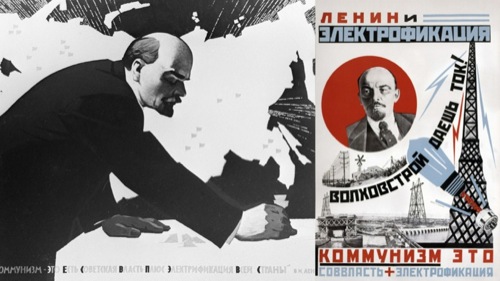 |
(Here are two more electrification posters from when the cool designers were still on Team Communism, before Socialist Realism stifled everything.) Termen was just what Lenin needed: a Soviet inventor with an electrical gizmo that would dazzle and amaze the masses, and help sell the suspicious countryside on electrification. He gave Termen a permanent rail pass, encouraging him to take his show on the road all over the Soviet Union. When Lenin died a few years later, Termen sent urgent word that Lenin's body be immediately frozen. He had an idea for how to bring him back to life, but it required putting the body on ice. He was devastated to learn that Lenin's brain had already been taken out and pickled in alcohol, and his body embalmed for public viewing. Given Termen's track record of technical achievemnt, it's probably a good thing he didn't get a chance at making zombie Lenin. |
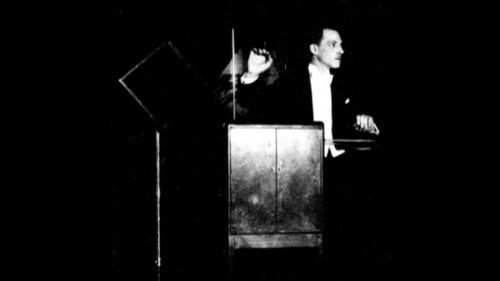 |
The new regime decided to send Termen abroad, to Europe. Once again he had a dual role: officially, he was a famous Soviet inventor sent to demonstrate the glorious achievements of the new workers' state amidst the dying embers of capitalism. His real job was to collect as much Western equipment and technical information as he could, to send back home. Termen took Europe by storm with a series of spectacular concert performances. These concerts all had the same structure. He would start with a lecture on the operating principles of the theremin, and then use various settings to have the instrument imitate animal sounds and the human voice. Then came the main portion of the concert, a musical recital with Termen playing slow Romantic pieces to orchestral accompaniment. In later demos, Termen added a visual effect called the Illumivox. Essentially a long rainbow strip of gelatin, it was rigged up to a projector so that colored light would shine on the wall behind him. The color displayed changed with the pitch of the note, like an early kind of screen saver. To the audience, it was magic. There were three factors that made Termen's demos unforgettable. In hindsight, they're independent of one other, but at the time all three seemed like integral parts of a new, electric 'ether music'. The first factor was that incredible interface, the spectacle of music being pulled out of thin air by the musician's hands. Ironically, it was a terrible interface for making music. The theremin plays like a 3D trombone. You have to hit your marks exactly in space, and it's hard to move between notes without a swooping and whooping effect (glissando). The mushiness of the interface limited the theremin to a repertoire of somewhat syrupy slow numbers. Players at the time tended to use a heavy vibrato, to mask inevitable inaccuracies in pitch. But as spectacle, that interface was sensational. Unlike all other electrical instruments, you could see that the Theremin was different. Even today the effect is amazing; it's hard for us to imagine the impression it must have made in the twenties. |
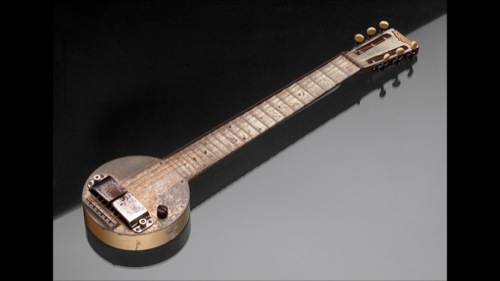 |
The second factor, curiously enough, was amplification. Today we think of amplification as separate from any particular instrument, but for many people in the audience, this was the first time they were hearing amplified music. And unlike other instruments, the Theremin had no natural volume. An amplifier was an integral part of its design, so it could play as loud as you cared to. The sight of a single instrument holding its own against an orchestra made a big impression. No one then could predict that electric amplification represented the real future of music, or that it would take a lowly backing instrument—the guitar—and turn it into a rock star. In these theremin demos amplification was not a thing apart, but part of what made electric music so revolutionary. |
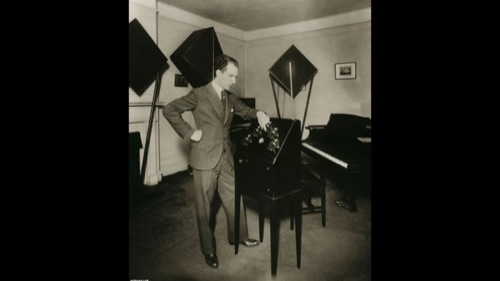 |
The third factor caught the imagination of composers and musically sophisticated listeners, who were not seduced by the shaky classical recital. Here was an invention that would remove artificial limits on tone color and sound that had burdened composers for millenia. No more need to scrape horse hair against intestine, or blow into pipes, to make musical sounds. Notes would longer be limited by the physical length of a violin bow, or how long the trumpeter could hold a breath. The full palette of sound, every imaginable kind of tone color and contour, lay open to exploration. You could now design sounds. This was the line of thinking that would ultimately lead to the synthesizer, and electronic music as we know it today. It was incredibly liberating, but also intimidating. After all, it's one thing to know that all constraints have been lifted; another to figure out what this utterly new music is supposed to sound like. |
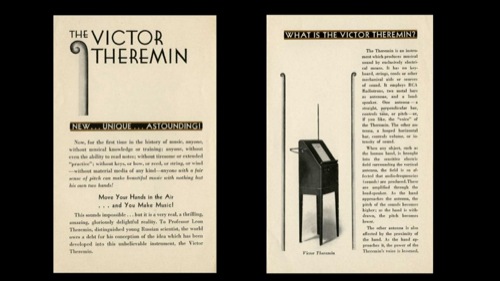 |
Before long, Stalin sent Termen to America, with instructions to ransack the patent offices there for useful inventions. America is a practical country, and the Americans seized on a practical question: can these theremins make us any money? RCA and Victor decided to test the market by building a few hundred theremins for sale to the public. They took a familiar marketing angle. By freeing people from having to learn an arbitrary and difficult set of hand positions, the spiel went, the theremin made it possible for anyone to create music! You simply waved your hands and pulled music from the ether. They envisioned a theremin in every home, and even had a design for a combination theremin and radio receiver that let you play along to your favorites in a kind of capacitative karaoke. Given that the instrument is one of the hardest to play, handwaving was an appropriate sales pitch for the theremin. |
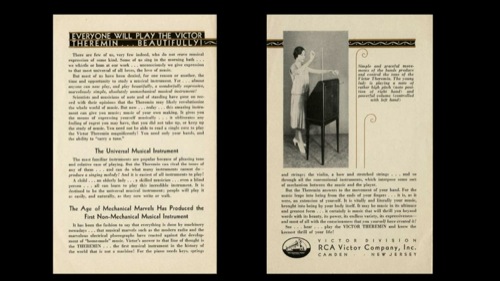 |
But let's imagine the theremin had lived up to its billing. I'm fascinated by this vision of a country of latent musicians, frustrated by outdated and expensive musical instruments, waiting for their creativity to be unlocked. It's a dream we seem to have every time there's a big new technology shift. Blogging will make us a nation of writers! Digital video and YouTube will make everyone a filmmaker! In their enthusiasm, RCA and Victor seemed to overlook that we all already have a touchless, intuitive, analog musical instrument that lives in our face, and yet few of us use it outside the shower. And each time we have this dream, there is the inevitable disappointment when it turns out most people don't want to write 6,000 word investigative journalism, or make art cinema, or buy a really expensive theremin. In the lovely words of our age, most people prefer to consume content, not create it. |
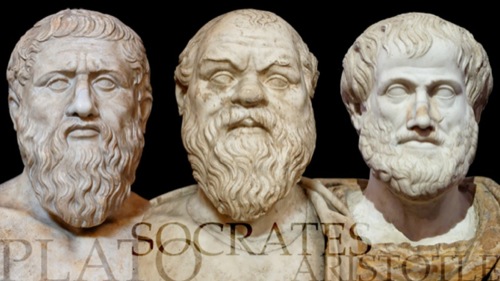 |
But there's something to this idea that we can't easily dismiss. If you look at human history, there are periods where a demographically small group of people has created content out of all proportion to their numbers. The great content creators of Ancient Greece, for example, who out of a fairly small population of free citizens gave us math, philosophy, and naked oil wrestling. You can argue that the Greeks had the advantage of going first. But there are so many later examples. |
 |
Consider 17th century Flanders, the Golden Age of oil painting. The cumulative population of Flanders over the century beginning in 1600 was around one million people, yet this tiny piece of Europe produced enough virtuoso painters to fill a phone book. The paintings made during the Dutch Golden Age are still unsurpassed.
The same thing happened in the Harlem Renaissance, and the Scottish Enlightenment, and in lots of other times and places. A tiny population of creators would spring out of nowhere and leave us with some of the greatest content in human history. New Zealand has around four million people, which means by this reckoning the country should have four Rembrandts. So where are they? Where is the Wellington Socrates? Where does this talent hide in more normal times? Is it just there all the time, going to waste, or is there some alchemy that creates it when conditions are right? It's a big mystery, and one we've never solved, no matter what Malcolm Gladwell says. That's why we keep having these moments of hope every time a technology demolishes barriers to creativity. Maybe this will be the big one! Maybe Songsmith really will make everyone's life a musical! |
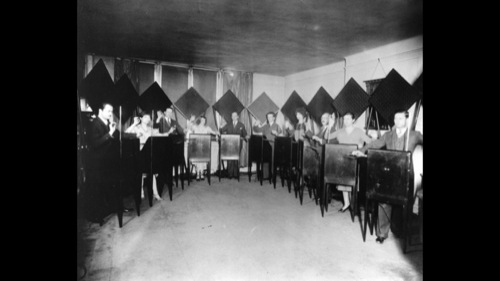 |
Termen never had a head for business, though he threw himself into the roaring twenties with enthusiasm, filing patents, creating shell company after shell company, and generally getting his finances in a very American knot. He was more interested in where this new ether music was heading. There was a big rush in those days towards synthetic forms of art that would combine vision, motion, and all the senses together. Termen was an enthusiast himself. In addition to the Illumivox, he started experimenting with other enhancements to his road show: seat handrests that changed texture with the music, a force-feedback glove, even (inevitably) odors and aromas that filled the concert hall in time with the music. |
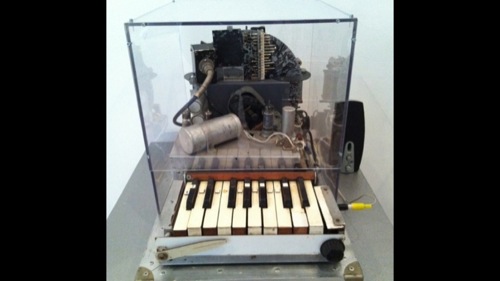 |
He collaborated with the magnificent madman Joseph Schillinger, who sought to automate the entire process of composing music, and believed he had come up with mathematical laws of art. He would do tricks like take the day's stock prices and convert them into a hit song. Gershwin and Glenn Miller, among others, were fascinated by his system. Termen made him the world's first drum machine, called the Rhythmicon, where the rhythm was determined by the pitch of the note. |
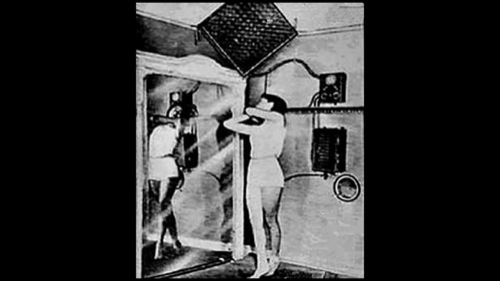 |
Termen also created the ultimate electric instrument, one so intuitive that no one could play it. Called the Terpsitone, it was basically a motion-sensitive dance floor. No more need for dancers to synchronize their movements to an awkward accompaniment. Instead, they would create their own music by simply moving their bodies! The only person ever able to get a melody out of the thing was his ablest student, Clara Rockmore, who liked playing with it in private but refused to give public recitals. Towards the end of his time in the US, Termen was exploring what we now call gaze detection, making it possible to play music just by looking in different directions. He was fascinated, too, by direct thought control, and was investigating how to use the faint fields generated by brain activity as a musical interface. Both of these technologies, of course, are at the forefront of current research. But Termen had run out of time. |
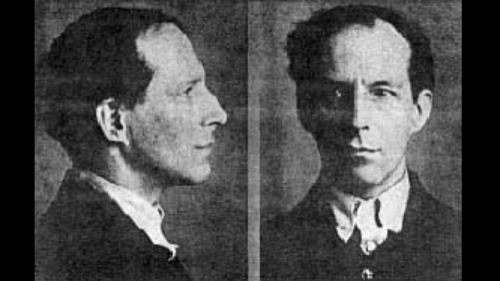 |
In 1938, Termen returned to the Soviet Union. There's debate about whether he did so voluntarily. It was the worst possible time to go back. Lenin's electrification programme had succeeded, and the Soviet Union was now an industrial powerhouse. And Soviet power was certainly going strong. But instead of adding up to give us communism, the two factors had produced that other great innovation of the 20th century, the totalitarian state. 1938 was the height of Stalin's war against the Russian intelligentsia, the Great Terror. Termen, with his years in the West, didn't stand a chance. You can see his mug shot here from when he was arrested, just weeks after his return. The secret police sent him to die in the labor camps of Kolyma. Termen will be in jail for a long time, so while we wait for World War II to release him, let me take the opportunity for a rant. |
 |
RANT Technology concentrates power. In the 90's, it looked like the Internet might be an exception, that it could be a decentralizing, democratizing force. No one controlled it, no one designed it, it was just kind of assembling itself in an appealing, anarchic way. The companies that first tried to centralize the Internet, like AOL and Microsoft, failed risibly. And open source looked ready to slay any dragon. But those days are gone. We've centralized the bejesus out of the Internet now. There's one search engine (plus the one no one uses), one social network (plus the one no one uses), one Twitter. We use one ad network, one analytics suite. Anywhere you look online, one or two giant American companies utterly dominate the field. And there's the cloud. What a brilliant name! The cloud is the future of online computing, a friendly, fluffy abstraction that we will all ascend into, swaddled in light. But really the cloud is just a large mess of servers somewhere, the property of one American company (plus the clouds no one uses). Orwell imagined a world with a telescreen in every room, always on, always connected, always monitored. An Xbox One vision of dystopia. But we've done him one better. Nearly everyone here carries in their pocket a tracking device that knows where you are, who you talk to, what you look at, all these intimate details of your life, and sedulously reports them to private servers where the data is stored in perpetuity. I know I sound like a conspiracy nut framing it like this. I'm not saying we live in an Orwellian nightmare. I love New Zealand! But we have the technology. When I was in grade school, they used to scare us with something called the permanent record. If you threw a spitball at your friend, it would go in your permanent record, and prevent you getting a good job, or marrying well, until eventually you'd die young and friendless and be buried outside the churchyard wall. What a relief when we found out that the permanent record was a fiction. Except now we've gone and implemented the damned thing. Each of us leaves an indelible, comet-like trail across the Internet that cannot be erased and that we're not even allowed to see. The things we really care about seem to disappear from the Internet immediately, but post a stupid YouTube comment (now linked to your real identity) and it will live forever. And we have to track all this stuff, because the economic basis of today's web is advertising, or the promise of future advertising. The only way we can convince investors to keep the money flowing is by keeping the most detailed records possible, tied to people's real identities. Apart from a few corners of anonymity, which not by accident are the most culturally vibrant parts of the Internet, everything is tracked and has to be tracked or the edifice collapses. What upsets me isn't that we created this centralized version of the Internet based on permanent surveillance. What upsets me, what really gets my goat, is that we did it because it was the easiest thing to do. There was no design, forethought, or analysis involved. No one said "hey, this sounds like a great world to live in, let's make it". It happened because we couldn't be bothered. Making things ephemeral is hard. Making things distributed is hard. Making things anonymous is hard. Coming up with a sane business model is really hard—I get tired just thinking about it. So let's take people's data, throw it on a server, link it to their Facebook profiles, keep it forever, and if we can't raise another round of venture funding we'll just slap Google ads on the thing. "High five, Chad!" "High five, bro!" That is the design process that went into building the Internet of 2014. And of course now we are shocked—shocked!—when, for example, the Ukrainian government uses cell tower data to send scary text messages to protesters in Kiev, in order to try to keep them off the streets. Bad people are using the global surveillance system we built to do something mean! Holy crap! Who could have imagined this? Or when we learn that the American government is reading the email that you send unencrypted to the ad-supported mail service in another country where it gets archived forever. Inconceivable! I'm not saying these abuses aren't serious. But they're the opposite of surprising. People will always abuse power. That's not a new insight. There are cuneiform tablets complaining about it. Yet here we are in 2014, startled because unscrupulous people have started to use the powerful tools we created for them. We put so much care into making the Internet resilient to technical failures, but make no effort to make it resilient to political failure. We treat freedom and the rule of law like inexhaustible natural resources, rather than the fragile and precious treasures that they are. And now, of course, it's time to make the Internet of Things, where we will connect everything to everything else, and build cool apps on top, and nothing can possibly go wrong. |
 |
Not long ago before I flew here, Google announced it was acquiring Nest, a luxury thermostat maker. I never thought I would use those two words together. Nest has sensors that detect who is in a room and when, so naturally there was concern that Google would now learn all this extra information about you, and know how hot your house is. Google quickly deployed the Nest CEO, who promised that there would be safeguards and a privacy policy, and all kinds of limits to make sure everything stayed kosher. And I have no reason to disbelieve the guy. But I shouldn't need his word, or Google's corporate motto, or Magna Carta, or the Treaty of Waitangi to protect me from my thermostat. My old thermostat wasn't that scary! It was too dumb to snitch. And no one could hear it scream. This new thermostat, on the other hand, has lawyers, PR people, a privacy policy, it's off writing blog posts somewhere, possibly eating my leftover pizza. It more like a sketchy roommate than a thermostat. Let me make it clear what I'm worried about here. I'm not afraid of my appliances. I'm not afraid that Google is going to send me to the Googlag to mine bitcoins. Nor am I afraid of a Greater New Zealand, grown drunk with electronic surveillance, aggressively expanding to control the Pacific Rim. That might be a nice change! If it happens, I will be waiting on the docks of San Francisco, bearing a basket of avocados, ready to welcome our Kiwi overlords. What I'm afraid of is the society we already live in. Where people like you and me, if we stay inside the lines, can enjoy lives of comfort and relative ease, but God help anyone who is declared out of bounds. Those people will feel the full might of the high-tech modern state. Consider your neighbors across the Tasman, stewards of an empty continent, who have set up internment camps in the remotest parts of the Pacific for fear that a few thousand indigent people might come in on boats, take low-wage jobs, and thereby destroy their society. Or the country I live in, where we have a bipartisan consensus that the only way to preserve our freedom is to fly remote controlled planes that occasionally drop bombs on children. It's straight out of Dostoevski. Except Dostoevski needed a doorstop of a book to grapple with the question: “Is it ever acceptable for innocents to suffer for the greater good?” And the Americans, a more practical people, have answered that in two words: “Of course!” Erika Hall in her talk yesterday wondered what Mao or Stalin could have done with the resources of the modern Internet. It's a good question. If you look at the history of the KGB or Stasi, they consumed enormous resources just maintaining and cross-referencing their mountains of paperwork. There's a throwaway line in Huxley's Brave New World where he mentions "800 cubic meters of card catalogs" in the eugenic baby factory. Imagine what Stalin could have done with a decent MySQL server. We haven't seen yet what a truly bad government is capable of doing with modern information technology. What the good ones get up to is terrifying enough. I'm not saying we can't have the fun next-generation Internet, where everyone wears stupid goggles and has profound conversations with their refrigerator. I'm just saying we can't slap it together like we've been doing so far and expect everything to work itself out. The good news is, it's a design problem! You're all designers here - we can make it fun! We can build an Internet that's distributed, resilient, irritating to governments everywhere, and free in the best sense of the word, like we dreamed of in the 90's. But it will take effort and determination. It will mean scrapping permanent mass surveillance as a business model, which is going to hurt. It will mean pushing laws through a sclerotic legal system. There will have to be some nagging. But if we don't design this Internet, if we just continue to build it out, then eventually it will attract some remarkable, visionary people. And we're not going to like them, and it's not going to matter. |
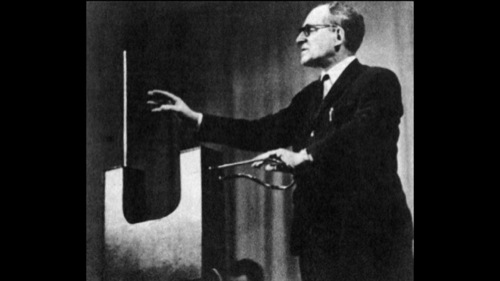 |
I had to make the rant long because we don't know much about the second half of Termen's life. He didn't like to talk about it. World War II saved his life. He was put to work in an institution only the Soviet Union could have invented, a prison filled with the greatest engineers and aerodynamicists in the country. After the war, it's clear that he worked on a lot of listening devices. In addition to 'The Thing', he developed an even more innovative system called Buran, which listened to the vibrations in a window pane by reflecting a beam of light off of it. This is still cutting-edge stuff today. Termen built a laser microphone before there were even lasers or digital noise correction. It won him the Stalin Prize, and his freedom. Stalin didn't know that Buran was being used against him, by his own security chief. Those wacky Bolsheviks! Termen was now free, but that black mark in his permanent record made him unemployable. So he went back to work in the KGB. In the 1960's, senior staff at the KGB became obsessed with UFOs and psychic phenomena, and they put Termen to work on that. He considered it a waste of time. Harsh words from a guy who wanted to defrost Lenin! People who met Termen after the war remarked on the fact that he would barely move his lips while he talked, a habit born of life under constant surveillance. In the late 60's, Termen left spy work and got a university job doing acoustical research. One day a visiting Western journalist ran in to Termen, and unfortunately reported the fact that he was still alive in the New York Times. This was too much for Termen's boss, who took all of Termen's musical instruments outside and chopped them up with an axe. “Electricity is only good for making electric chairs,” he explained. And that was the end of Termen's university career. This is what oppression often looks like. No one called from Moscow and told this guy to destroy Termen's work. But he didn't care to stick his neck out, and took a proactive approach. The rest of Termen's life was spent trying to carve out a little space in which to work. He was assigned a tiny single room in a communal apartment, which he filled with equipment and old files. He never stopped giving theremin lessons. He spent his last years trying to drum up interest in a device called the time microscope. There were tiny corpuscles in the blood which you could see if you used the proper high-speed photographic equipment. They were the key to immortality. People who invited Termen to music conferences at the end of his life took great pains to keep him quiet about the time microscope. Thus stymied, he died in November of 1993, when he was 97 years old. |
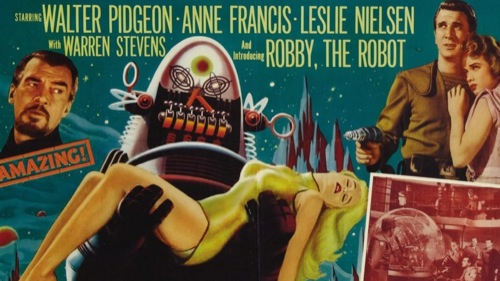 |
We know what legacy the Theremin had in the West. In the 1930's it was featured in the scores of a couple of films about mentally deranged protagonists. Theremin music became associated with psychological thrillers, and eventually pure science fiction. It had that exotic, disturbing sound.
Despite the efforts of players like Clara Rockmore, and occasional cameos in popular music, like Good Vibrations, the theremin remained a niche instrument. The few session musicians who could play it made a handsome living doing film scores. |
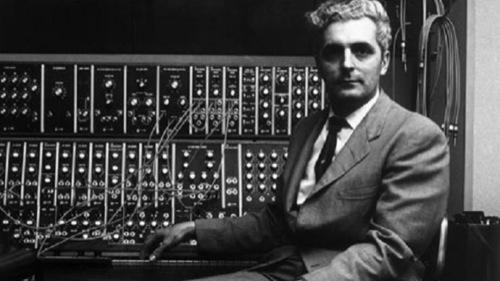 |
But the theremin had that power to seize the imagination. It inspired a generation of people like Robert Moog, the great synthesizer pioneer, who started out making theremins and never lost his passion for them. Moog considers repairing Clara Rockmore's original theremin to be the highlight of his career. |
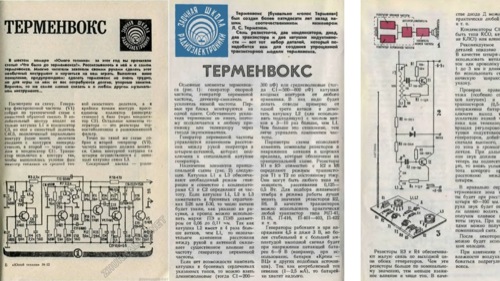 |
What made the instrument so durable was its beautiful simplicity. Not just as an interface, but as a circuit. It's one of the simplest 'real' radio circuits you can build. Termen's original design required just five vacuum tubes. So it was always a mainstay of home electronics projects, and a great starting point for experiments. It was hackable in the best sense of the word. And of course the theremin, and Termen, have another legacy, in every device with a capacitative touchscreen. Those phones in your pocket aren't just surveillance devices, but little theremins, able to track the position of your fingers with the same electrical magic that Termen used to create music. I think it’s wonderful that the man’s legacy extends there. |
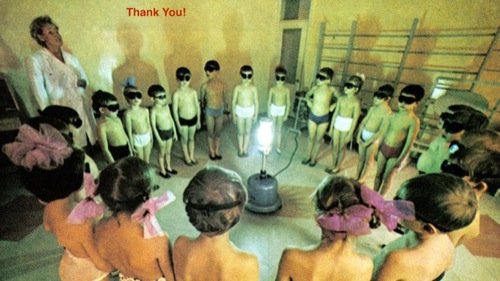 |
I want to close with my favorite Termen anecdote, from the end of his life. Termen spent years trying to join the Communist party, and they kept making excuses to turn him away. When he was ninety years old, he applied again, but they told him that to join he had to take a five-year advanced course in Marxism-Leninism. So he did it. He went to night school and did it. In 1991, literally weeks before the fall of the Soviet Union, Termen got his party badge. The 95-year-old Bolshevik was briefly the youngest Communist in the country. Naturally people asked him, “Lev Sergeyevich, why on Earth would you join the Communist Party now, when everyone else is leaving?” He gave them the most badass answer imaginable: “I promised Lenin.” I promised Tasha and Mike I would keep my talk to thirty minutes. Thank you all very much! THUNDEROUS, SUSTAINED APPLAUSE |